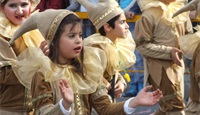
Applicant:
Limassol Municipality
Communities Concerned - Bearers of the element:
Limassol Municipality and citizens-participants in the Limassol Carnival
Domain of Intangible Cultural Heritage:
Oral traditions and expressions
Social practices, rituals and festive events
Traditional craftsmanship
Date of inscription:
2015
Geographical location and range of the element:
The Limassol Carnival is the oldest and most popular pagan festival in Limassol and in Cyprus more broadly. Historically, the Carnival tradition was celebrated all over Cyprus, however with the passage of time it assumed such a great importance in Limassol that it was eventually associated to the town and became an integral part of its special identity.
Brief Description:
Apart from being a city tradition, the Carnival also constitutes a family tradition passed on from one generation to the next with great enthusiasm. The main features of the Carnival are the consumption of meat and wine, satire, dancing and singing – especially serenades – as well as masquerading and dressing-up in various fancy dress costumes. During the modern celebrations of the Carnival, the Municipality of Limassol plays an important role, as it hosts an 11-day festival including parades, dancing in the streets, fancy-dress competitions and cultural events. The official opening of the Carnival is marked on “Tsiknopempti”, or Fat Thursday (ten days before Lent). On this day the inhabitants of Limassol meet at various points of the historical centre where they revive traditional carnival customs, such as the “tsiknomata” (consumption of different kinds of barbecued meat), the serenades and the impromptu parties. Carnival events culminate over the two following weekends – Carnival Sunday and Shrove Sunday – with the children’s and the main Carnival parade attracting thousands of participants both locals and foreigners.
Although the celebration of Carnival is documented in Cyprus from the Lusignan and the Venetian periods, in Limassol it began to show a noteworthy development over recent years and in particular in the beginning of the British Rule (late 19th- early 20th century). In the old times the celebrations used to be simple and traditional with big banquets of food and drink, Cypriot folk dances and songs (mainly “tsiattista” poetic duelling) and improvised last minute dressing-up since people were too poor to afford ready-made fancy dress costumes and they used to make the most of clothes and props they had at home.
With the passage of time, the traditional Cypriot Carnival customs and happenings were gradually set aside and eventually a European type of urban Carnival prevailed. Nevertheless, there are certain traditional Carnival customs that are still alive today, thus creating an amalgam of traditional and modern elements, rural folk and urban habits as well as imported and local features. The masqueraders are today inspired by a variety of themes, such as historical events, current affairs and political issues, heroes from mythology and fairytales, cinema movies and traditions of foreign countries. However, the older and more traditional masquerades are the “crazy masks”: these are improvised masquerades aiming on the one hand to conceal the real identity of those dressing-up and on the other hand to provoke laughter and entertainment.
An important role in creating a Carnival atmosphere as well as reinforcing the local character is played by the groups of serenade-singers. Serenades are traditionally sung by male choirs, usually accompanied by the mandolin and the guitar and constitute the real “sound of the city”, as the majority of people in Limassol consider them part of their cultural identity. This type of music developed around the middle of the 19th century and was influenced both by the Ionian and the Athenian serenades which have Italian and western features. Nowadays, even for the residents of the rest of Cyprus, serenades and Carnival songs are fully associated with Limassol and its inhabitants and mainly the Limassol Carnival.